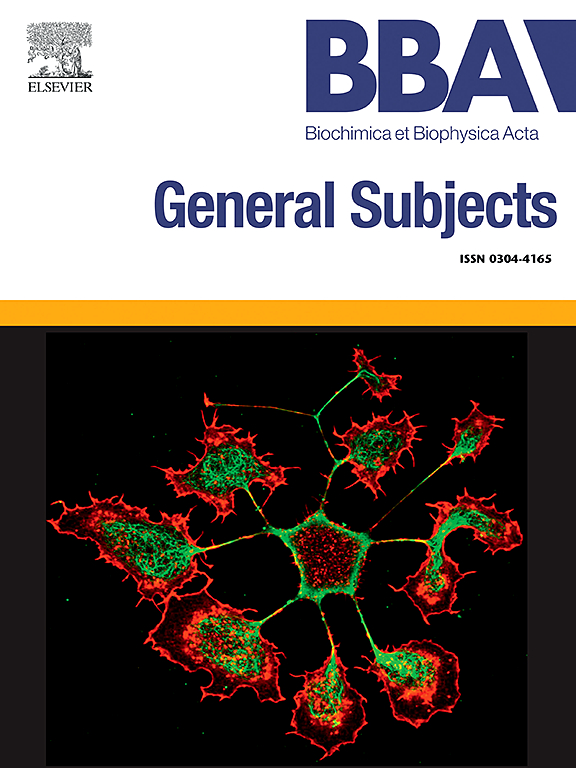在丝状蓝藻Anabaena PCC 7120中,Hik2-Rre1相互作用是一个双组分信号系统。
IF 2.2
3区 生物学
Q3 BIOCHEMISTRY & MOLECULAR BIOLOGY
Biochimica et biophysica acta. General subjects
Pub Date : 2025-08-29
DOI:10.1016/j.bbagen.2025.130853
引用次数: 0
摘要
光合生物通常依靠双组分调节系统来适应环境变化。该系统通过控制基因表达,将外部信号与应答机制连接起来,最终使生物体适应各种应激,这是至关重要的。特别是蓝藻,拥有大量的这种双组分系统。叶绿体感应激酶(Chloroplast Sensor Kinase, CSK)是存在于所有光合生物体内的一种保守的组氨酸激酶。本研究对丝状蓝藻Anabaena PCC 7120中发现的CSK同源物Hik2进行了研究,以了解其在该生物信号传导机制中的作用。重组Hik2在一个保守的组氨酸残基上进行自磷酸化,该残基不受低盐浓度的影响,但在高盐浓度下略有抑制。通过芯片分析,Rre1被确定为Hik2的潜在合作伙伴。进一步的实验,包括下拉和表面等离子体共振分析,证实了Hik2和Rre1之间的物理相互作用。有趣的是,在Rre1存在的情况下,Hik2的快速去磷酸化表明磷酸化从Phospho-Hik2转移到其同源伙伴Rre1。硅分析进一步确定了Anabaena Rre1可能的热响应调控,提示Hik2-Rre1相互作用可能在Anabaena PCC 7120的信号传导机制中发挥作用。总的来说,这项研究揭示了Hik2-Rre1相互作用在促进丝状蓝藻信号过程中的重要性,为这些光合生物的适应机制提供了有价值的见解。本文章由计算机程序翻译,如有差异,请以英文原文为准。
The Hik2-Rre1 interaction acts as a two-component signaling system in filamentous cyanobacterium Anabaena PCC 7120
Photosynthetic organisms often rely on two-component regulatory system to adapt to environmental changes. This system is crucial for connecting external signals with the response mechanism by controlling gene expression, eventually allowing the organism to acclimatize to various stresses. Cyanobacteria, in particular, possess a large number of these two-component systems. Chloroplast Sensor Kinase (CSK) is a conserved histidine kinase present in all photosynthetic organisms.
In the present study, Hik2, a CSK homolog found in the filamentous cyanobacterium Anabaena PCC 7120, was investigated to understand its role in the signaling mechanism of this organism. Recombinant Hik2 was found to undergo autophosphorylation on a conserved histidine residue, which remains unaffected by low salt concentrations but is slightly inhibited at elevated concentrations. Rre1 was identified as a potential partner for Hik2 through in silico analysis. Further experiments, including pull-down and surface plasmon resonance analysis, confirmed a physical interaction between Hik2 and Rre1. Interestingly, rapid dephosphorylation of Hik2 in the presence of Rre1 suggested a phosphotransfer from Phospho-Hik2 to its cognate partner Rre1. In silico analysis further identified probable heat-responsive regulons of Anabaena Rre1, suggesting the possible role of the Hik2-Rre1 interaction in the signaling mechanism of Anabaena PCC 7120.
Overall, this study sheds light on the importance of the Hik2-Rre1 interaction in facilitating signaling processes in filamentous cyanobacteria, providing valuable insights into the acclimatization mechanisms of these photosynthetic organisms.
求助全文
通过发布文献求助,成功后即可免费获取论文全文。
去求助
来源期刊

Biochimica et biophysica acta. General subjects
生物-生化与分子生物学
CiteScore
6.40
自引率
0.00%
发文量
139
审稿时长
30 days
期刊介绍:
BBA General Subjects accepts for submission either original, hypothesis-driven studies or reviews covering subjects in biochemistry and biophysics that are considered to have general interest for a wide audience. Manuscripts with interdisciplinary approaches are especially encouraged.
 求助内容:
求助内容: 应助结果提醒方式:
应助结果提醒方式:


